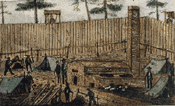 |
Confederate P.O.W. Camps |
|
State War Records |
| AL - AK - AZ - AR - CA - CO - CT - DE - FL - GA - HI - ID - IL - IN - IA - KS - KY - LA - MA - MD - ME - MI - MN - MS - MO - MT - NE - NV - NH - NJ - NM - NY - NC - ND - OH - OK - OR - PA - RI - SC - SD - TN - TX - UT - VT - VA - WA - WV - WI - WY |
Florence Stockade Prisoner of War Camp
Search, View, Print Union & Confederate Civil War Prisoner of War Records, 1861-1865

Confederate 1864-1865
Florence, South Carolina
The Florence Prison was in operation for approximately 5 months during the time period of Sept 1864 through Feb 1865. During this time, as many as 15,000 - 18,000 Union soldiers were held captive. Of these, approximately 2,802 Union soldiers died.
The idea of building a stockade at Florence began when Gen. William T. Sherman, after capturing Atlanta, posed a great threat towards liberating the Union soldiers held captive at Andersonville and other southern Georgia stockades. It was determined that the prisoners had to be moved out of the path of Sherman's advancing troops. Florence was chosen by Confederate authorities for the site of a new prison due to the fact that there were 3 railroads that centered in the town, which would ease the operation of transporting and receiving prisoners. Florence was a point 80 miles east of Columbia.
Maj. Gen. Samuel Jones ordered Maj. Frederick F. Warley, who had been recently exchanged from a Northern prison camp, to construct a stockade in Florence. Work began with approximately 1,000 slaves being assigned to the project from the local area.
A group of prisoners were sent to Florence prison when Andersonville was being threatened of being overrun by Union forces.
During the construction of the stockade, there was a rapidly deteriorating situation in Charleston due to the spread of such diseases as Small Pox & Yellow Fever. Due to this situation, 5 to 6,000 of the prisoners were sent to Florence before the completion of the stockade, arriving in Florence on the 14th of September. Since the stockade was far from complete when the prisoners began to arrive, they were gathered into a field close to the train tracks. Being assembled in an open field made the possibility of escape a reality and was of great concern to Maj. Warley, not to mention the fact that the prisoners were "in a state of mutiny" and could cause major problems in the surrounding area; including the possible destruction of the railroads. Warley requested assistance from Maj. General Roswell S. Ripley, the commander at Charleston, to help with the situation. Due to the imminent danger involved, Warley couldn't wait and sent out trains to the surrounding community to gather every available man to assist in the completion of the stockade. The prisoners were finally moved into the stockade on the first Sunday of October 1864.
The design of the stockade was much like that of Andersonville. Upright un-hewn timbers were sunk about 5 feet into the ground encasing about 23 1/2 acres; 6 acres were swamp. The walls of the stockade were roughly 1,400-feet by 725 feet and approximately 12 - 16 feet tall. Like Andersonville, a stream ran through the center of the stockade. This stream was slightly larger than the one at Andersonville, but still proved to be inadequate.
One major difference in the design changes between Andersonville and Florence is that a deep trench was dug around the Florence Stockade to eliminate prisoners from trying to tunnel out. The soil from the trench was then pushed up against the outer walls of the stockade, which provided a platform for the guards to man their posts and also added stability to the log walls. Some accounts also state that there was an inner trench or furrow, as well as a row of boards, used for the deadline.
An additional difference, in comparing Andersonville to Florence, was that the trees previously within the boundaries of the walls had recently been cut, leaving many stumps behind, which were used as firewood. There were also several smaller trees left inside, which were put to the same use. Also, wood was supplied to the stockade, although in small amounts. This wood was gathered during the winter months by a prisoner wood squad.
Maj. Warley had been wounded prior to his imprisonment and the building of the Florence Stockade. His wounds began to bother him and he requested to be relieved of his duties at the stockade, being replaced by Col. George P. Harrison, Jr. of the 32nd Georgia by September 20, with Lt. James Barrett of the 5th Georgia in command of the interior of the stockade. Harrison became known for his fair treatment of prisoners. While, on the other hand, Barrett was known for being the most brutal. Lt. Barrett escaped from being arrested and charged with crimes by fleeing to Germany where he married and remained many years. He would die later of natural causes in 1910 at Augusta, Georgia.
LIFE & CONDITIONS:
By October 12th of 1864, there were 12,362 prisoners at the stockade, with a death rate of between 20 and 30 per day. At this time, 3/4 of the prisoners were without blankets, and quite a few were close to being naked. Luckily, a supply of goods and clothes were delivered to the stockade from the Sanitary Commission about the middle of October.Around the first of November, another supply of clothes arrived at the stockade from the Sanitary Commission. These items were dispersed to the prisoners who were in most need of them. Also, around this time, the northwest corner of the stockade was separated from the main part for the construction of a hospital, which consisted of rude barracks.
The prisoners totaled 11,424 for November, and towards the end of the month, orders came to make out parole rolls for the most severely sick and wounded prisoners. Any prisoner wishing to be paroled had to undergo an inspection to determine if his case was severe enough to be paroled.
On December 6, 1864, public criticism led to the appointment of Lt. Col. John F. Iverson as the commander of the stockade. During the first half of December, the prisoners who were selected for parole were sent by rail to Charleston where they would stay for a few days before boarding the flag-of-truce boats. After their parole, they were shipped to Camp Parole, Annapolis, Maryland. Due to these paroles the number of prisoners had decreased to 7,538 with the death rate decreasing to 6 per day for January 1865.
Brig. Gen. John H. Winder, commander of all of the Confederate prisons east of the Mississippi, was at Florence when he died of a heart attack in front of the Sutler Tent on February 6th, 1865. Due to an inadequate water supply and its close proximity to Union cavalry, Winder had been trying to close the stockade at Florence. After Winder's death, Col. Henry Forno made preparations to have the prisoners relocated. Sherman had cut the last railroad link to southwest Georgia, so it was decided to have the prisoners relocated to North Carolina. After much discussion about what to do with the prisoners, all able-bodied prisoners were sent to Greensboro, where they would be paroled and sent to Camp Parole. Most of the sick and wounded prisoners were sent to N. E. Ferry at Wilmington to be paroled as well. By the end of February 1865, the stockade was empty.
The Florence Stockade has not received the same notoriety as Andersonville, but the conditions were very much the same. In fact, by many accounts, Florence was worse. It must also be realized that most of the prisoners at Florence had already survived a hard summer at Andersonville and now faced going through the winter with little to no clothing or shelter.
